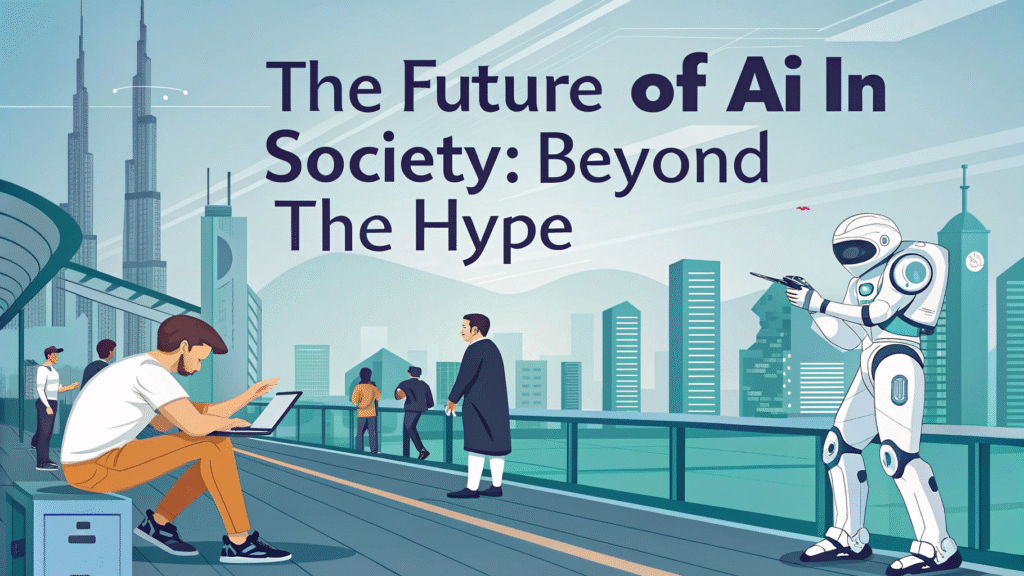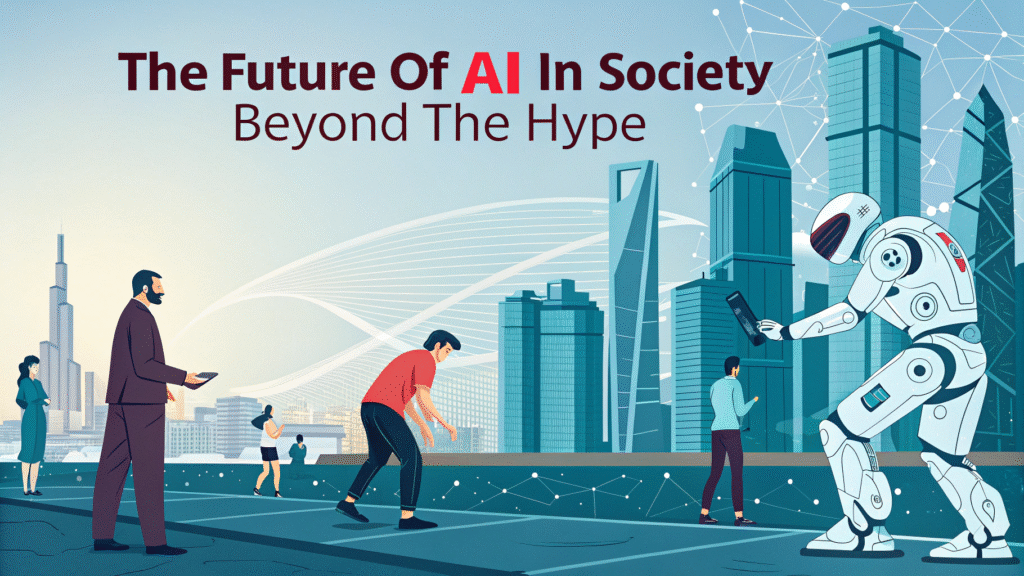
Introduction
From science fiction to everyday reality, Artificial Intelligence is no longer a distant concept. We are living through its rapid integration into the fabric of our daily lives. Understanding the future of AI in society is crucial, not just for technologists, but for everyone—entrepreneurs building the next big thing, marketers connecting with audiences, and creators shaping our culture. This article moves beyond the hype to explore the tangible ways AI will transform our world, the challenges we must navigate, and the opportunities that lie ahead.
From Calculator to Co-pilot: A Brief History
AI’s journey to the mainstream has been a series of breakthroughs. It began in the mid-20th century as a theoretical discipline focused on simple problem-solving. For decades, progress was slow, trapped in what were known as “AI winters.” However, the convergence of big data, powerful computer hardware, and sophisticated algorithms like deep learning ignited a new era. Landmarks like IBM’s Deep Blue beating a chess champion and the rise of voice assistants marked its arrival. Now, with the explosion of generative AI, we’ve entered a phase where AI is less of a specialized calculator and more of a versatile co-pilot for human endeavor.
Who Will Be Shaped by AI’s Future?
The ripple effects of advanced AI will touch every demographic, but some groups will feel its impact more directly and immediately:
- The Workforce: From factory floor operators to white-collar analysts, virtually no profession will remain untouched by automation and augmentation.
- The Next Generation: Students and young professionals are entering a world where AI literacy will be as fundamental as computer skills are today.
- Business Leaders & Entrepreneurs: They face the dual task of leveraging AI for competitive advantage while managing the ethical and operational shifts it demands.
- Policymakers & Educators: These groups hold the responsibility for creating the regulatory frameworks and educational systems that will guide the future of AI in society.
- Consumers & Citizens: Everyone will interact with AI through personalized services, healthcare, and even the information they consume, making digital literacy paramount.
Key Areas Set for Transformation
AI’s impact won’t be uniform; it will revolutionize specific sectors in profound ways.
Healthcare: The Personalized Medicine Revolution
AI is poised to make healthcare predictive and personalized. It will be used to:
- Analyze medical images with superhuman accuracy for earlier disease detection.
- Accelerate drug discovery by simulating molecular interactions.
- Power wearable devices that provide real-time health monitoring and alerts.
The Workplace: Automation and Augmentation
The narrative of AI simply taking jobs is incomplete. The future is one of transformation:
- Automation of Repetitive Tasks: AI will handle data entry, scheduling, and basic customer queries, freeing humans for higher-level work.
- Human-AI Collaboration: Professionals will use AI as a tool for enhanced creativity and data analysis, leading to roles like “AI-assisted designer” or “data strategist.”
Creative Industries: The New Renaissance
AI is emerging as a powerful muse and tool for creators:
- It can generate initial design concepts, write marketing copy, and compose music.
- This forces a redefinition of creativity, shifting the human role toward curation, direction, and imbuing work with emotional depth.
Daily Life: The Invisible Assistant
AI will become further woven into the mundane, making life more convenient:
- Smarter home systems that anticipate your needs.
- Hyper-personalized education platforms that adapt to each student’s learning pace.
- More efficient and safer autonomous transportation networks.
The Business and Marketing Potential
For forward-thinking businesses, the future of AI in society is a goldmine of opportunity.
- Hyper-Personalization at Scale: Marketers can use AI to deliver uniquely tailored content, product recommendations, and customer experiences to millions of individuals simultaneously.
- Unprecedented Operational Efficiency: AI optimizes supply chains, predicts maintenance needs, and automates back-office functions, drastically reducing costs.
- Data-Driven Innovation: Businesses can uncover hidden patterns in market data to identify new product opportunities and emerging trends before competitors.
- Enhanced Customer Service: AI-powered chatbots and support systems can provide instant, 24/7 assistance, resolving common issues and escalating complex ones.
Navigating the AI Frontier: Best Practices
To thrive in this new era, individuals and organizations should adopt a proactive mindset.
- Embrace Lifelong Learning: Continuously update your skills. Focus on capabilities that AI complements rather than replaces, like critical thinking, empathy, and strategic leadership.
- Develop AI Literacy: Understand what AI is, what it can do, and, just as importantly, its limitations. This is essential for making informed decisions.
- Prioritize Ethical Implementation: Build trust by using AI transparently and responsibly. Be clear about when and how AI is being used, especially with customer data.
- Start with a Problem, Not a Tool: Don’t implement AI for its own sake. Identify a specific business or personal challenge and explore if AI provides the best solution.
- Foster a Collaborative Culture: Encourage teams to experiment with AI tools and share insights. The most successful organizations will be those that learn to partner with AI.
Challenges and Ethical Limitations
The path forward is not without significant hurdles. We must confront:
- Job Displacement and Economic Inequality: While industries will create new jobs, the transition could still cause pain. Moreover, it may widen the gap between skilled and unskilled workers. As a result, governments and businesses must act to reduce inequality.
- Algorithmic Bias and Fairness: AI systems trained on biased data can perpetuate and even amplify societal prejudices, leading to unfair outcomes in hiring, lending, and law enforcement.
- Data Privacy and Surveillance: The data-hungry nature of AI raises profound questions about personal privacy and the potential for mass surveillance.
- Accountability and Control: As AI systems become more complex, determining who is responsible for their actions—especially in cases of error or harm—becomes increasingly difficult.
- The Misinformation Threat: Generative AI can create highly convincing fake content, threatening to erode public trust in media and institutions.
The Future Outlook: What’s Next?
Looking ahead, we can anticipate several key developments that will further define the future of AI in society:
- The Rise of Explainable AI (XAI): Researchers and developers will push to create AI systems with decisions humans can understand and trust. This clarity is crucial for medicine and finance.
- Stronger Global Governance: As AI grows more powerful, nations will establish robust international frameworks and regulations. These efforts mirror the rules already emerging for data privacy.
- AI for Global Grand Challenges: Organizations and innovators will deploy AI to address massive issues such as climate change, pandemic prediction, and resource management.
- The Human-AI Symbiosis: The most exciting frontier is the growing partnership between human and machine intelligence. This collaboration will spark breakthroughs we cannot yet imagine.

Conclusion
The future of AI in society is not predetermined; rather, it is a canvas we are painting together. On one hand, AI provides powerful tools to solve age-old problems. On the other hand, it raises profound ethical dilemmas. Ultimately, the outcome will depend on the choices we make today—how we educate our children, how we regulate technology, and how we integrate AI into our lives with wisdom and foresight. Therefore, by embracing AI with optimism, responsibility, and a commitment to human-centric values, we can guide its development. In the end, this approach can create a future that benefits all of humanity.